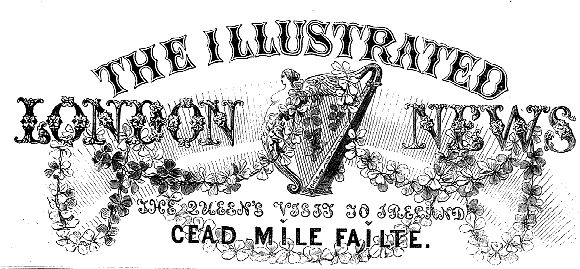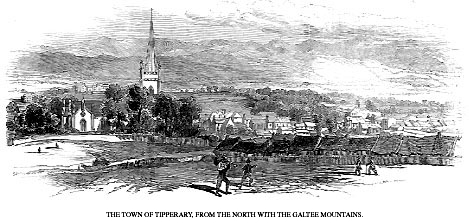
|
THE ILLUSTRATED LONDON NEWS. |
[Sept. 2, 1848. |
![]()
SKETCHES IN IRELAND
(By our Special Correspondent.)
WE returned to the town of Thurles, in Tipperary, after accompanying the train which brought the prisoners to Dublin; but finding nothing occur to detain us at Thurles, which, for three weeks following the insurrectionary affray near Ballingarry, had been the locality of chiefest interest to the military, the police, and the reporters, we set our faces westward, and occasionally southward, on a tour through Tipperary county. It is about seventy miles long from north to south, and about forty miles broad from east to west, and comprises an area of 1659 square miles. Its surface in acres measures 1,061,731. Of those acres 843,887 are stated to be "arable" (that is cultivated-- though in many respects badly cultivated), while 178,183 are wholly uncultivated, 23,779 are covered with plantations, 2359 form the sites of towns, and 13,523 are under water.

It is generally level or gently undulating, except on its borders, where southward we see the Galtees, the Knockmeledown ranges, and the Slievenamon solitary mountain; and in the east, where we see the Slieve Ardagh hills; and the west, where a group rises with the Keeper, shutting out the setting sun. The fame of Tipperary for agrarian outrages every ear has heard. The beauty of its surface no tongue can sufficiently declare. There is no English county that resembles it. Its wheat, its orchards, its high hedgerows, luxuriant and flowery in their wildness, you may see equalled in Kent; but Kent is without the mountains and the music of the rivers of Tipperary. On the other hand, weeds attempt to grow in the farm fields of Kent, as they do here; but they do not choke up the wheat and overcome its growth, and keep the potatoes often undermost, as they do here. Wages sufficient to induce men and women to work are paid in Kent; not so in Tipperary. Nothing is so continually manifest to the observer here, as the want of labour in the fields, and the number of people everywhere without employment, and declaring that nobody will employ them, not even at sixpence per day.
The population of the county was, at the taking of the last census, 435,553. There were 34,100 farms of more than one acre each (the average seems to run between 15 and 30 acres). The principal towns are Clonmel, with a population of 13,000; Nenagh, 8648; Carrick-on-Suir, 11,049; Thurles, 7523; Cashel, 7036; Roscrea, 5275; Fethard, 3915; Cahir, 3668; Templemore, 3683; Clogheen, 2049; and Tipperary, from whence the county takes its name, 7370.

Tipperary town stands near the centre of the most fertile district of that fertile shire. It consists of one long main street running along an acclivity with a southern aspect, with lanes and other streets extending on each side. Viewed from a grassy eminence on the north side, we have before us the parish church; a row of mean cot houses, poorly thatched, inhabited by people poorly clothed, and complaining that they have no work to do; while, beyond the town, we have a view of the Workhouse and the Fever hospital, and another building, occupied at present as a barrack. Behind these rises a ridge of hills, the property chiefly of Augustus Stafford, Esq., M.P. (better known as Stafford O'Brien-- having but recently obtained the Royal license to change his name); and behind that ridge of hills rise the Galtee Mountains-- the vale of Aherle intervening. Viewed from the south, near the Workhouse, we have the unfinished railway station immediately before us, and the town, beautifully chequered with gardens and trees, rising beyond; those gardens, when we approach them and look over the walls, are so completely overgrown with thistles, docks, and luxuriant foulness, that you cannot tell nor even guess at the nature of the crop that may have been sown-- whether potatoes, turnips, or cabbages. Outside the walls, by the pathway sides, and at every street corner, men, women, and children, of all ages and sizes, are gathering around strangers to beg; and to every question of "Why are you begging and not working?" the reply is "There is no work to do."

From Tipperary we travelled to Cahir, eleven miles. This town occupies a situation of singular beauty on both banks of the Suir river. It is chiefly the property of the Earl of Glengall. The well-cultivated fields, rich in their crops of grain, now ripe, and in process of being harvested, prove that some causes have been at work to improve this district. We obtained access to the tower of the Bridewell, from whence a good view of the town and surrounding country is obtained. From a point on the river side, below the ancient castle and bridge, we took another view. The large flour mills, one of which is beside the bridge, are objects of industrial interest, which the traveller finds occurring more frequently on the river Suir than on any other river in the south of Ireland.
![]()